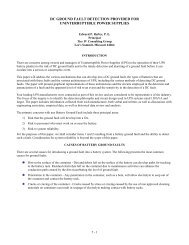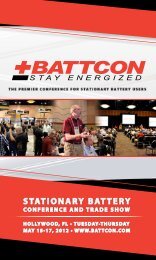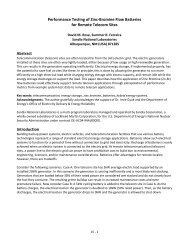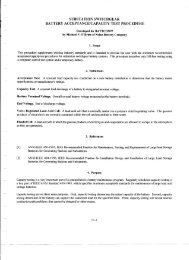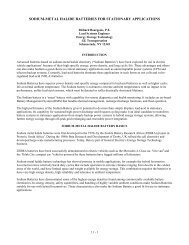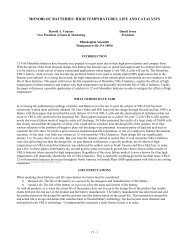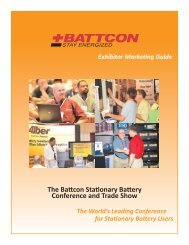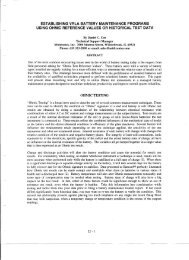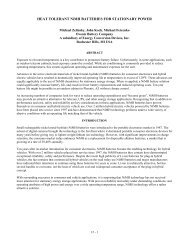FLOODED (VLA ), SEALED (VRLA), GEL, AGM TYPE, FLAT PLATE ...
FLOODED (VLA ), SEALED (VRLA), GEL, AGM TYPE, FLAT PLATE ...
FLOODED (VLA ), SEALED (VRLA), GEL, AGM TYPE, FLAT PLATE ...
You also want an ePaper? Increase the reach of your titles
YUMPU automatically turns print PDFs into web optimized ePapers that Google loves.
The discharge power at the 10 min. rate is 50% higher for the flat plate battery as the tubular. Even if we take the higher<br />
manufacturing costs into account, we get 30% more 10 min. power per $. The 60 min-rate is the crossover point. Then,<br />
between 200 and 300 min. (3h to 5h-rate), we get 20% more power per $ for the tubular cells. The results are similar for the<br />
smaller sizes (ca.310Ah). Speaking just from the performance data, it is more economical to use flat plate batteries of the<br />
above design for bridging times of 60 min. and shorter, while for bridging times of 1h and longer, tubular plate batteries are<br />
more economical.<br />
Life time comparison of <strong>VLA</strong> flat and tubular plates<br />
For nuclear power plants, lead acid batteries have to be qualified according to IEEE 535-1986. The qualification was made<br />
with vented as well as valve-regulated batteries. To simulate the required life time of 15 years at 23°C, the cells had to be<br />
floated at 62,8°C (145°F) and tested every 50 days the 3h-rate capacity at room temperature.<br />
OPzS<br />
OPzV<br />
OGi<br />
vented<br />
valve-regulated<br />
vented<br />
type<br />
tubular<br />
tubular - <strong>GEL</strong><br />
flat<br />
density<br />
float V<br />
1,24g/ml 2,23V<br />
1,24g/ml 2,25V<br />
1,24g/ml 2,23V<br />
samples<br />
6 cells 200Ah<br />
3 cells 200Ah<br />
3 cells 480Ah<br />
samples<br />
6 cells 490Ah<br />
3 cells 490Ah<br />
3 cells 800Ah<br />
samples<br />
6 cells 2000Ah<br />
3 cells 2000Ah<br />
3 cells 1520Ah<br />
Figure 3. Sample cells for lifetime and seismic tests<br />
Figure 4. Heating chamber for the 62,8°C test<br />
After 250 days at 62,8°C, the cell capacities were still well above 100%, so we did a real time history seismic and an airplane<br />
crash experiment with accelerations up to 12m/s²: There was no damage afterwards and capacities were unchanged.<br />
6 - 3



